Multicriteria Quantification of the Compatibility of the Targets from Romania’s Relevant Strategies with the European Green Deal
Abstract
:1. Introduction
2. Literature Review
3. Materials and Methods
- In terms of GHG emissions, Romania is well below the EU average, with an emission intensity of 537.6 g equiv. CO2/1 EUR, which can be compared with the EU average of 266.5 g equiv. CO2/1 EUR.
- Under the energy efficiency aspect, energy productivity had a value of 5.2 EUR/kg in Romania, which can be compared with the EU average of 8.57 EUR/kg.
- Under the aspect of the valorization of renewable energy resources, the gross final consumption index of RER had values of 24.48% in Romania and 22.09% in the EU.
- Are structured on the same five domains, which we rank according to their importance on OV, as follows: environment (EN), energy (E), SRE industry (I), transport (T), and buildings (B).
- Are numerically unequal (19 TE and 29 TN), with the following distribution by domains:
- Contain some targets that are unclear, irrelevant, or superfluous, being included, practically, in others that are more comprehensive. For this reason, for the comparative numerical evaluations, we will work with a set of clear, relevant, comprehensive targets, such as this: TE—all, TN—those registered in matrix (2).
- Are unequal in terms of importance regarding the impact on vital objectives. Here, we are not referring to the importance viewed in terms of the scope of the geographical and economic area to which the target refers (EU—very large, RO—small) but to the importance in terms of the effect on GHG reduction, that is, to the scale to which the target is applied. From this point of view, we consider that the targets can be grouped into three categories, in which—for the purpose of quantification—we will give them different importance factors (IFs), as follows:
4. Results
5. Discussion
5.1. The Purpose of the Work
5.2. Romania’s National Strategies
5.3. Level of Targets
6. Conclusions
Author Contributions
Funding
Institutional Review Board Statement
Informed Consent Statement
Data Availability Statement
Conflicts of Interest
References
- Felea, I.; Felea, A.I. Analysis of the compatibility of Romania’s relevant strategies with the European Green Deal, Oradea. J. Sustain. Energy 2022, 13, 89–93. [Google Scholar]
- Artis, M.J.; Nixson, F. The Economics of the European Union. In Policy and Analysis, 4th ed.; Oxford University Press: Oxford, UK, 2007. [Google Scholar]
- The Brundtland Report. Paper Presented at UN. 1987. Available online: http://www.un-documents.net/wced-ocf.htm (accessed on 3 April 2023).
- European Commission. European Commission Documents: Competitiveness Advisory Group. Climate action. Enhanding European Competitiveness. 1995. Available online: http://ec.europa.eu/clima/politics/brief/eu/index_en.htm (accessed on 3 April 2023).
- United Nations. Human Development Report. 1999. Available online: https://digitallibrary.un.org/record/286004#record-files-collapse-header (accessed on 3 April 2023).
- European Commission. A Final Report for The European Commission Directorate-General Regional Policy—A Study on the Factors of Regional Competitiveness; European Commission Documents; Cambridge Econometrics, University of Cambridge: Cambridge, UK, 2003. [Google Scholar]
- Popescu, I.; Bondrea, A. Constantinescu. In Sustainable Development. A Romanian Perspective; Economic Publishing House: Bucharest, Romania, 2005. [Google Scholar]
- Munasinghe, M. Environmental Economics and Sustainable Development; World Bank Paper; The World Bank: Washington, DC, USA, 1993. [Google Scholar]
- Felea, A.I. Increasing the Competitiveness of the Romanian Economy in the Context of Sustainable Development. Ph.D. Thesis, University of Oradea, Oradea, Romania, 2014. [Google Scholar]
- Bubbico, R.L.; Dijkstra, L. The European regional Human Development and Human Poverty Indices. Reg. Focus 2011, 2, 1–10. [Google Scholar]
- Eurostat. 2023. Available online: https://ec.europa.eu/eurostat (accessed on 6 April 2023).
- Lisbon Strategy 2000. Available online: http://circa.europa.eu/irc/opoce/fact_sheets/info/data/policies/lisbon/article_7207_ro.htm (accessed on 3 April 2023).
- Felea, A.I. Competitiveness and Sustainable Development. An Integrated Strategic Approach at the Level of Romania and the EU; Publishing House of the University of Oradea: Oradea, Romania, 2015; ISBN 978-606-10-1529-0. [Google Scholar]
- Single European Act. 1987. Available online: https://eur-lex.europa.eu/legal-content/EN/TXT/?uri=celex%3A11986U%2FTXT (accessed on 4 April 2023).
- Maastricht Treaty. 1993. Available online: https://www.europarl.europa.eu/about-parliament/en/in-the-past/the-parliament-and-the-treaties/maastricht-treaty (accessed on 4 April 2023).
- Gothenburg Summit. 2001. Available online: https://www.consilium.europa.eu/media/20983/00200-r1en1.pdf (accessed on 6 April 2023).
- European Commission. Sustainable Development Strategy. 2006. Available online: https://data.consilium.europa.eu/doc/document/ST-10917-2006-INIT/en/pdf (accessed on 6 April 2023).
- Europe 2020 Strategy. 2010. Available online: https://eur-lex.europa.eu/LexUriServ/LexUriServ.do?uri=COM:2010:2020:FIN:en:PDF (accessed on 6 April 2023).
- European Union. Climate change—European Climate Deal. 2019. Available online: https://climate-pact.europa.eu/index_en (accessed on 6 April 2023).
- European Commission. Consequences of climate change. 2023. Available online: https://climate.ec.europa.eu/climate-change/consequences-climate-change_en (accessed on 6 April 2023).
- European Council. The Paris Agreement on Climate Change—Consilium. Available online: https://www.consilium.europa.eu/en/policies/climate-change/paris-agreement/ (accessed on 3 April 2023).
- Sixth Assessment Report of the Intergovernmental Panel on Climate Change. Available online: https://www.ipcc.ch/2021/08/09/ar6-wg1-20210809 (accessed on 6 April 2023).
- Cattivelli, V. Macro-Regional Strategies, Climate Policies and Regional Climatic Governance in the Alps. Climate 2023, 11, 37. [Google Scholar] [CrossRef]
- Dillman, K.; Heinonen, J. Towards a Safe Hydrogen Economy: An Absolute Climate Sustainability Assessment of Hydrogen Production. Climate 2023, 11, 25. [Google Scholar] [CrossRef]
- van der Spek, M.; Banet, C.; Bauer, C.; Gabrielli, P.; Goldthorpe, W.; Mazzotti, M.; Munkejord, S.T.; Røkke, N.A.; Shah, N.; Sunny, N.; et al. Perspective on the hydrogen economy as a pathway to reach net-zero CO2 emissions in Europe. Energy Environ. Sci. 2022, 15, 1034–1077. [Google Scholar] [CrossRef]
- Borowski, P.; Barwici, J. Efficiency of Utilization of Wastes for Green Energy Production and Reduction of Pollution in Rural Areas. Energies 2023, 16, 13. [Google Scholar] [CrossRef]
- Dillman, K.; Heinonen, J. Testing the Role of Trade on Carbon Dioxide Emissions in Portugal. Economies 2021, 9, 22. [Google Scholar]
- Wijaya, N.; Nitivattananon, V.; Shrestha, R.P.; Kim, S.M. Drivers and Benefits of Integrating Climate Adaptation Measures into Urban Development: Experience from Coastal Cities of Indonesia. Sustainability 2020, 12, 750. [Google Scholar] [CrossRef]
- Antolín, J.; de Torre, C.; García-Fuentes, M.Á.; Pérez, A.; Tomé, I.; Mirantes, M.L.; Hoyos, E. Development of an Evaluation Framework for Smartness and Sustainability in Cities. Sustainability 2020, 12, 5193. [Google Scholar] [CrossRef]
- Guerrero-Liquet, G.C.; Sánchez-Lozano, J.M.; García-Cascales, M.S.; Lamata, M.T.; Verdegay, J.L. Decision-Making for Risk Management in Sustainable Renewable Energy Facilities: A Case Study in the Dominican Republic. Sustainability 2016, 8, 455. [Google Scholar] [CrossRef]
- Peri, M.; Vandone, D.; Baldi, L. Volatility Spillover between Water, Energy and Food. Sustainability 2017, 9, 1071. [Google Scholar] [CrossRef]
- Marttunen, M.; Mustajoki, J.; Sojamo, S.; Ahopelto, L.; Keskinen, M. A Framework for Assessing Water Security and the Water–Energy–Food Nexus—The Case of Finland. Sustainability 2019, 11, 2900. [Google Scholar] [CrossRef]
- Ali, S.; Jang, C.-M. Optimum Design of Hybrid Renewable Energy System for Sustainable Energy Supply to a Remote Island. Sustainability 2020, 12, 1280. [Google Scholar] [CrossRef]
- Sixt, G.N.; Strambo, C.; Zhang, J.; Chow, N.; Liu, J.; Han, G. Assessing the Level of Inter-Sectoral Policy Integration for Governance in the Water–Energy Nexus: A Comparative Study of Los Angeles and Beijing. Sustainability 2020, 12, 7220. [Google Scholar] [CrossRef]
- Sarkodie, S.A.; Ajmi, A.N.; Adedoyin, F.F.; Owusu, P.A. Econometrics of Anthropogenic Emissions, Green Energy-Based Innovations, and Energy Intensity across OECD Countries. Sustainability 2021, 13, 4118. [Google Scholar] [CrossRef]
- Romero-Perdomo, F.; Carvajalino-Umaña, J.D.; Moreno-Gallego, J.L.; Ardila, N.; González-Curbelo, M. Research Trends on Climate Change and Circular Economy from a Knowledge Mapping Perspective. Sustainability 2022, 14, 521. [Google Scholar] [CrossRef]
- Matak, N.; Mimica, M.; Krajačić, G. Optimising the Cost of Reducing the CO2 Emissions in Sustainable Energy and Climate Action Plans. Sustainability 2022, 14, 3462. [Google Scholar] [CrossRef]
- Ciot, M.-G. On European Green Deal and Sustainable Development Policy (the Case of Romania). Sustainability 2021, 13, 12233. [Google Scholar] [CrossRef]
- Doskočil, R. The Multicriteria Assessment of the Green Growth in the Context of the European Union’s Green Deal. Amfiteatru Econ. 2022, 24, 739–757. [Google Scholar] [CrossRef]
- Felea, I.; Adrian, I.F. The Multidimensional Characterization of Romania’s Energetic Competitiveness, 12th Edition—FOREN. In Tomorrow’s Energy: From Vision to Reality; World Energy Council Central & Eastern Europe Energy Forum: Bucharest, Romania, 2014. [Google Scholar]
- The European Green Deal. 2019. Available online: https://commission.europa.eu/strategy-and-policy/priorities-2019-2024/european-green-deal_en (accessed on 7 April 2023).
- National Recovery and Resilience Plan. Ministry of Investments and European Projects of Romania. 2021. Available online: https://mfe.gov.ro/pnrr/ (accessed on 7 April 2023).
- The Romanian Government. 2023. Available online: https://www.gov.ro/ (accessed on 7 April 2023).
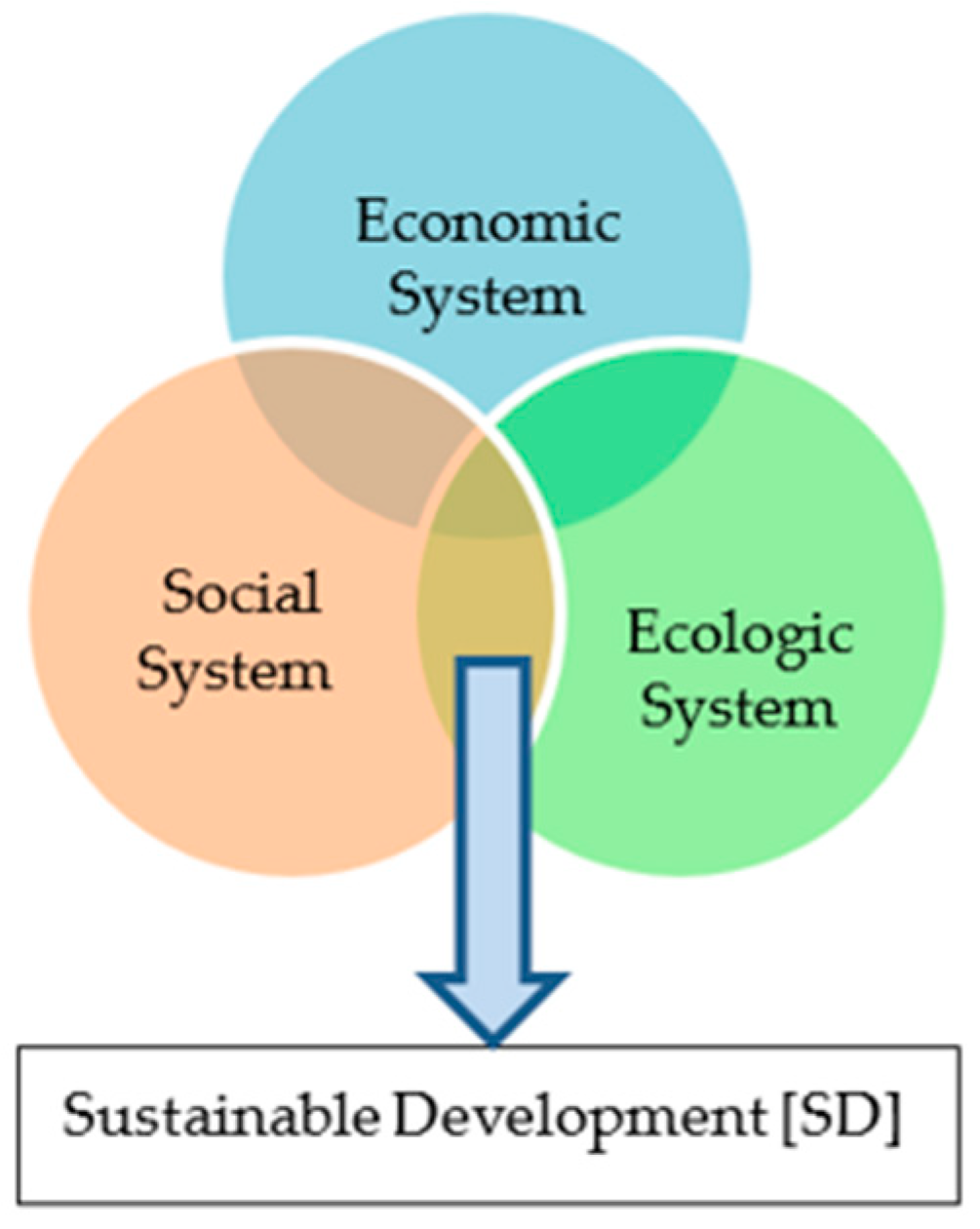
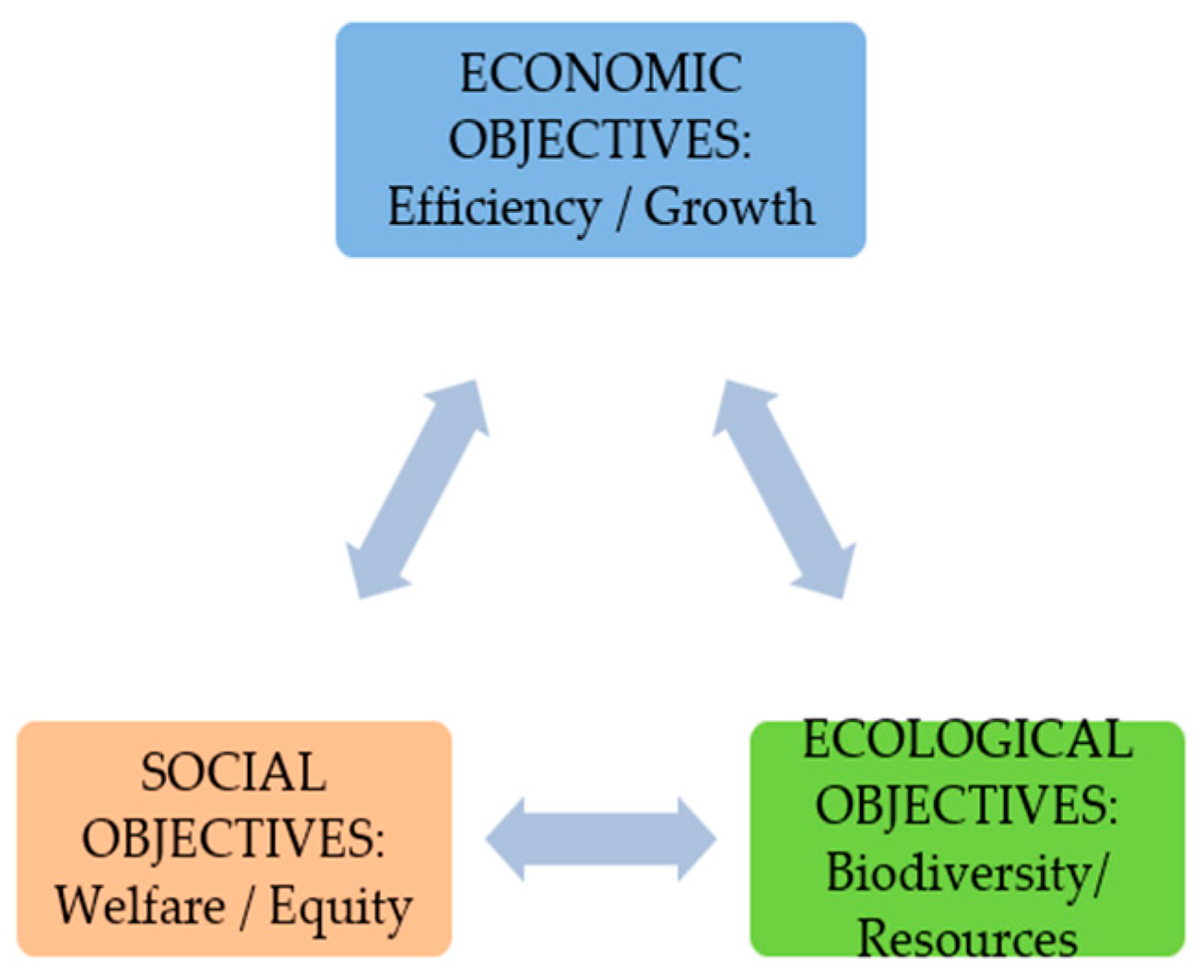
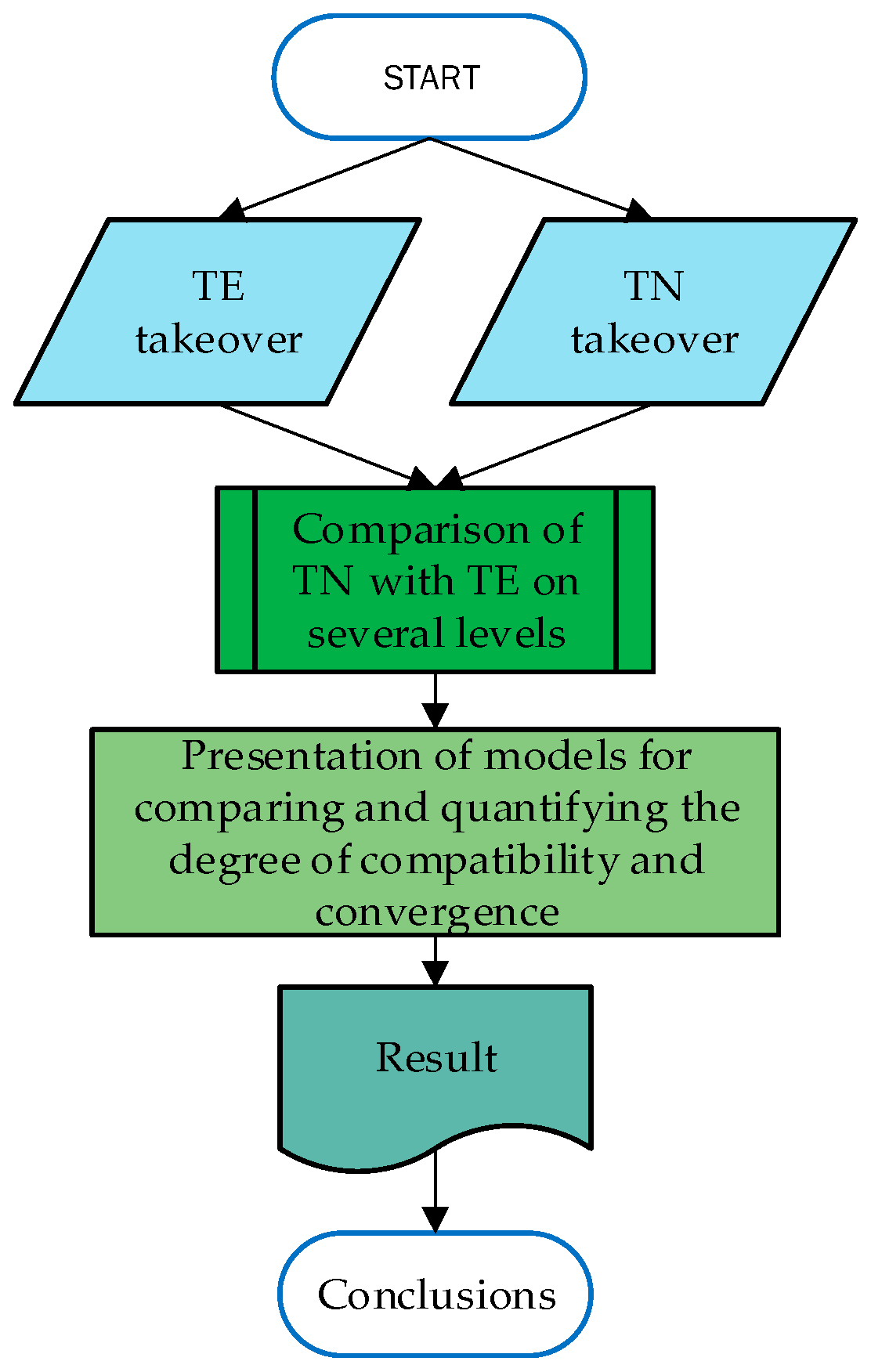
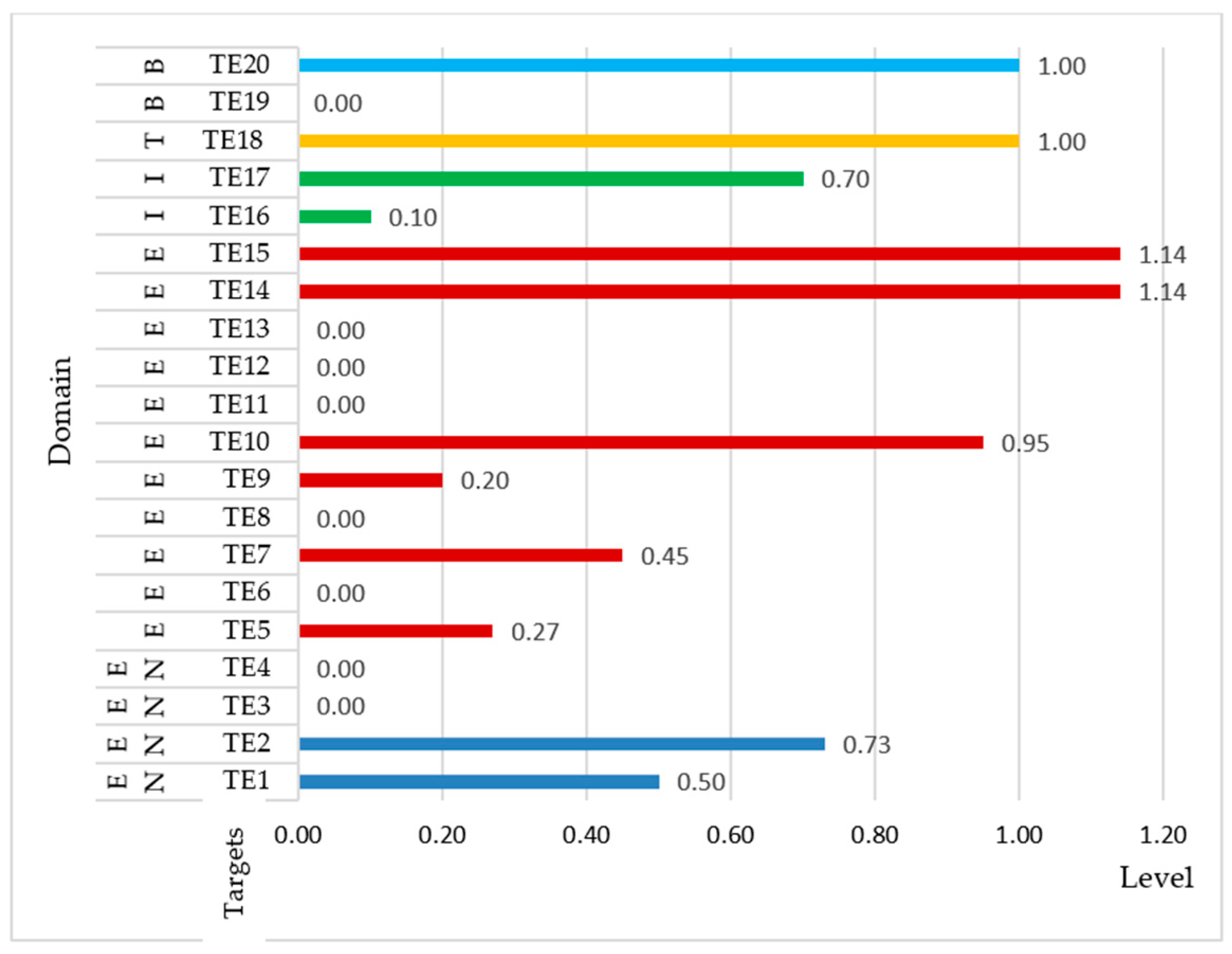
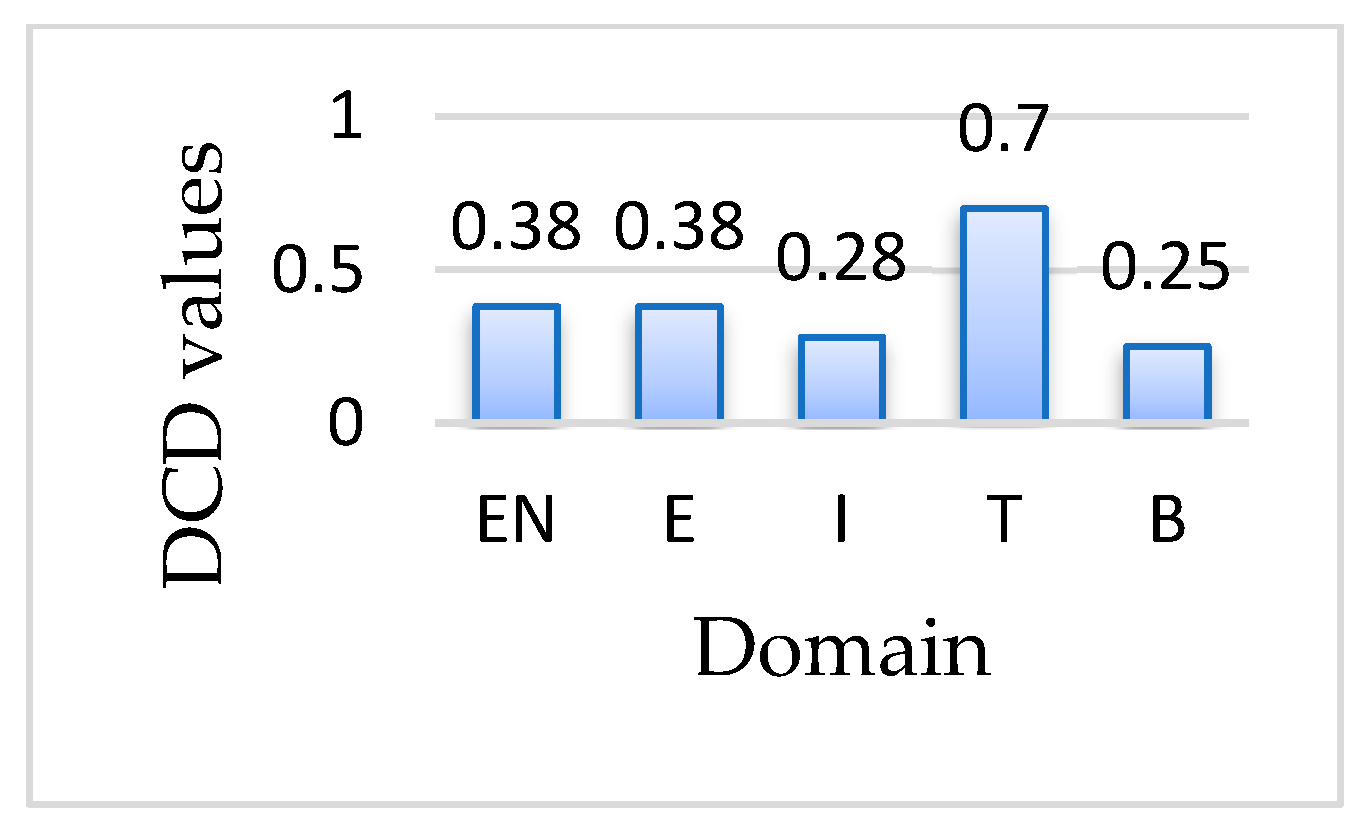
| No. | Field | Targets Assumed at EU Level (TE) |
|---|---|---|
| 1. | Environment [EN] |
|
| 2. | Energy [E] |
|
| 3. | Renewable energy industry [I] |
|
| 4. | Transport [T] |
|
| 5. | Buildings [B] |
|
| No. | Field | Romania’s Adopted Targets (TN) |
|---|---|---|
| 1. | Environment [EN] |
|
| 2. | Energy [E] |
|
| 3. | Renewable energy industry [I] |
|
| 4. | Transport [T] |
|
| 5. | Buildings [B] |
|
| No. | Domain | DC-Vector |
|---|---|---|
| 1. | Environment [EN] | (1, 1, 0, 0) |
| 2. | Energy [E] | (1, 0, 1, 0, 1, 1, 0, 0, 0, 1, 0) |
| 3. | Renewable energy industry [I] | (1, 1) |
| 4. | Transport [T] | (1) |
| 5. | Buildings [B] | (0, 1) |
| No. | Domain | DCT Values | DCD Values |
|---|---|---|---|
| 1. | Environment [EN] | {0.8, 0.73, 0, 0} | 0.38 |
| 2. | Energy [E] | {0.27, 0, 0.45, 0, 0.2, 0.95, 0, 0, 0, 1.14, 1.14} | 0.38 |
| 3. | Renewable energy industry [I] | {0.1, 0.7} | 0.28 |
| 4. | Transport [T] | {1} | 0.7 |
| 5. | Buildings [B] | {0, 1} | 0.25 |
Disclaimer/Publisher’s Note: The statements, opinions and data contained in all publications are solely those of the individual author(s) and contributor(s) and not of MDPI and/or the editor(s). MDPI and/or the editor(s) disclaim responsibility for any injury to people or property resulting from any ideas, methods, instructions or products referred to in the content. |
© 2023 by the authors. Licensee MDPI, Basel, Switzerland. This article is an open access article distributed under the terms and conditions of the Creative Commons Attribution (CC BY) license (https://creativecommons.org/licenses/by/4.0/).
Share and Cite
Felea, A.I.; Felea, I.; Hoble, C.R. Multicriteria Quantification of the Compatibility of the Targets from Romania’s Relevant Strategies with the European Green Deal. Sustainability 2023, 15, 13386. https://doi.org/10.3390/su151813386
Felea AI, Felea I, Hoble CR. Multicriteria Quantification of the Compatibility of the Targets from Romania’s Relevant Strategies with the European Green Deal. Sustainability. 2023; 15(18):13386. https://doi.org/10.3390/su151813386
Chicago/Turabian StyleFelea, Adrian Ioan, Ioan Felea, and Calin Radu Hoble. 2023. "Multicriteria Quantification of the Compatibility of the Targets from Romania’s Relevant Strategies with the European Green Deal" Sustainability 15, no. 18: 13386. https://doi.org/10.3390/su151813386
APA StyleFelea, A. I., Felea, I., & Hoble, C. R. (2023). Multicriteria Quantification of the Compatibility of the Targets from Romania’s Relevant Strategies with the European Green Deal. Sustainability, 15(18), 13386. https://doi.org/10.3390/su151813386





